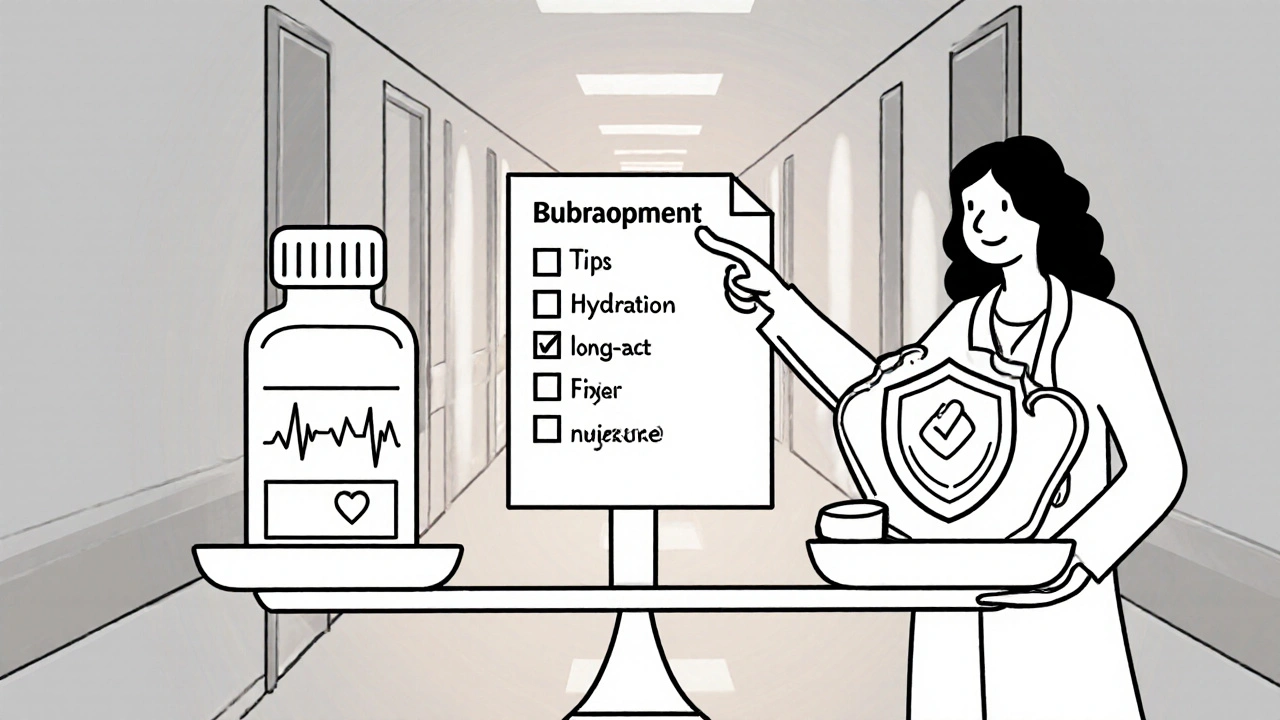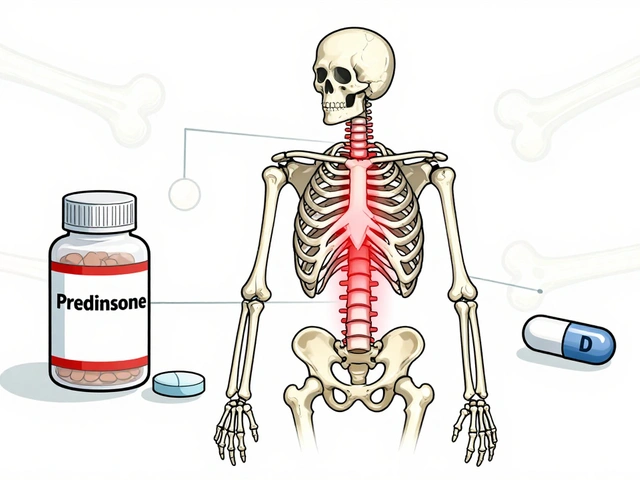Methadone vs Buprenorphine Side Effect Calculator
Personal Factors Assessment
Side Effect Risk Comparison
When you or a loved one faces opioid use disorder (OUD), the first question isn’t just “how do I stop?” but “what will the medication feel like?” Methadone and buprenorphine dominate medication‑assisted treatment (MAT), yet their side‑effect profiles differ enough to tip the scales for many patients. Below you’ll get a straight‑talk rundown of how each drug works, the most common and serious adverse effects, and practical tips for handling them.
What is Medication‑Assisted Treatment?
MAT blends FDA‑approved drugs with counseling and behavioral therapy. The goal is to blunt cravings, ease withdrawal, and lower overdose risk while keeping patients in care. Two drugs have become the backbone of MAT: Methadone is a full mu‑opioid receptor agonist that provides steady opioid activity throughout the day, preventing the highs and lows that drive relapse. It was first synthesized in Germany during World War II and entered U.S. clinics in 1947 (SAMHSA). The second, Buprenorphine is a partial mu‑opioid receptor agonist with a built‑in ceiling effect that caps respiratory depression, making it safer for unsupervised dosing. The buprenorphine/naloxone combo (commonly known as Suboxone) received FDA approval for OUD in 2002.
How Methadone Works and What to Expect
Because methadone fully activates the mu‑opioid receptor, it eliminates withdrawal symptoms and reduces cravings almost entirely. Its long half‑life (8-59 hours) means patients often need only one daily dose under supervision at an opioid treatment program (OTP). However, the same potency brings a distinctive side‑effect checklist.
- Common effects (15-40% of patients): lightheadedness, dizziness, sleepiness, nausea/vomiting, sweating, constipation.
- Sexual dysfunction: about 30% report impotence or reduced libido, a side effect that can strain relationships.
- Cardiac risk: QTc prolongation occurs in 5‑15% at standard doses and jumps to 25‑35% when daily doses exceed 100 mg. Baseline EKGs are now standard for high‑dose patients.
- Respiratory depression: linear dose‑response means overdose potential rises sharply with higher doses, especially during induction.
- Seizures: rare but documented in 1‑3% of long‑term users.
Most of these effects fade as the body reaches a stable dose, but the initial two‑to‑four‑week induction phase carries the highest risk. In fact, 78% of methadone‑related adverse events happen during this period (Providers' Clinical Support System, 2024).
How Buprenorphine Works and What to Expect
Buprenorphine’s partial agonist action means it activates the mu‑receptor enough to stave off withdrawal yet limits the ceiling of respiratory depression. This safety net allows office‑based prescribing, so patients don’t need daily visits to an OTP.
- Common effects (15-35%): lightheadedness, dizziness, sleepiness, nausea/vomiting, sweating, constipation - similar to methadone.
- Headaches: reported by 30‑40% of users, often managed with over‑the‑counter analgesics.
- Oral‑mucosal reactions: numbness, pain, or irritation at the sublingual site affect 25‑35%; about 15‑25% notice a lingering “mouth feeling” that can be uncomfortable.
- Ceiling effect: while it caps overdose risk (about 50% lower respiratory depression compared to methadone), it can leave high‑tolerance patients feeling under‑medicated, leading to breakthrough cravings.
Buprenorphine induction follows a “start low, go slow” protocol: 2‑4 mg initial dose after 12‑24 hours of opioid‑free time to avoid precipitated withdrawal (which still occurs in roughly 15‑25% of attempts). Once stabilized, patients can self‑administer at home, which improves flexibility but also shifts side‑effect monitoring to the patient and primary‑care provider.
Side‑Effect Comparison at a Glance
| Side Effect | Methadone | Buprenorphine |
|---|---|---|
| Lightheadedness / Dizziness | 15‑25% | 12‑20% |
| Sleepiness | 18‑28% | 18‑28% |
| Nausea & Vomiting | 20‑35% | 20‑35% |
| Constipation | 25‑40% | 25‑40% |
| Sexual Dysfunction | ~30% | ~5% |
| QTc Prolongation | 5‑15% (standard) / 25‑35% (>100 mg) | Rare (<2%) |
| Headaches | ~10% | 30‑40% |
| Oral‑Mucosal Issues | ~5% | 25‑35% |
| Overdose Fatality (Induction) | 2.5× higher than buprenorphine | Lower due to ceiling effect |
The table highlights why many clinicians view methadone as the “heavy‑duty” option: it scores better on cravings but carries higher cardiac and overdose risks. Buprenorphine shines for safety, especially when patients have co‑occurring depressants or unstable housing.
Practical Tips for Managing Side Effects
Whether you’re on methadone or buprenorphine, side‑effects can be tamed with a few proven strategies.
- Start Low, Go Slow: For both drugs, titrating up in small increments reduces dizziness and nausea. Most protocols add 5‑10 mg of methadone every 3‑5 days, whereas buprenorphine is increased by 2‑4 mg every 3‑7 days.
- Hydration & Fiber: Constipation affects up to 40% of methadone patients. Drink 2‑3 L of water daily, add a daily fiber supplement, and consider a stool softener early on.
- Cardiac Monitoring: If methadone dose exceeds 100 mg, request a baseline EKG and repeat every 6 months. Discuss any history of arrhythmia with your prescriber.
- Oral‑Mucosal Care: For buprenorphine, hold the tablet or film under the tongue for at least 5 minutes, avoid swallowing, and rinse the mouth with water after dosing to lessen irritation.
- Address Headaches: Over‑the‑counter NSAIDs work for most buprenorphine‑related headaches. If they persist, a short taper of caffeine may help.
- Sexual Health: Methadone‑induced impotence can often be mitigated by adjusting the dose or adding a phosphodiesterase‑5 inhibitor under doctor supervision.
- Co‑substance Caution: Combining either medication with benzodiazepines or alcohol spikes respiratory depression risk by 300‑400% (Nosyk et al., 2024). Use naloxone rescue kits; many clinics now co‑prescribe them.
Remember, side‑effects often improve after the first month as the body adapts. Keep a daily log of symptoms, dose, and any triggers; this record is gold for your prescriber.
Special Considerations
Pregnancy: Both drugs are Category C, but buprenorphine is preferred because it lowers neonatal abstinence syndrome severity. Methadone may still be used if the patient is already stable on it.
Drug Interactions: CYP2B6 polymorphisms affect methadone metabolism in roughly 30 % of patients, leading to higher plasma levels and more pronounced side‑effects. Buprenorphine is metabolized mainly by CYP3A4; strong inhibitors (ketoconazole, erythromycin) can raise levels.
Driving and Work: Studies (Rapeli, 2007) show methadone users have a 25‑30% deficit in visual memory tasks, which can impair driving. Buprenorphine’s milder cognitive impact makes it a safer choice for jobs requiring alertness, provided the ceiling dose isn’t exceeded.
Real‑World Voices
Reddit’s r/stopopiates community (2023‑24) surveyed 1,247 methadone users: 68% cited “severe constipation” and 55% reported “constant drowsiness” that interfered with work. By contrast, 73% of 893 buprenorphine users complained about “mouth numbness” and 47% felt the ceiling effect left them with occasional breakthrough cravings.
Healthgrades reviews (2024) gave methadone a 2.8/5 rating for side‑effects, with “feeling like a zombie” mentioned in 41% of negative comments. Buprenorphine earned a 3.5/5, praised for “manageable side‑effects” but critiqued for “inadequate symptom control” in high‑tolerance patients. These anecdotes line up with clinical data: methadone boasts higher retention (81.5% at 24 months) but also higher early dropout due to side‑effects (31% vs 24% for buprenorphine).

Emerging Developments
Long‑acting buprenorphine formulations are reshaping the side‑effect landscape. The monthly injection Sublocade (approved 2017) eliminates daily oral‑mucosal irritation for many, though 40‑50% report injection‑site pain. The six‑month implant Probuphine reduces systemic exposure, cutting nausea and constipation rates by roughly one‑third.
For methadone, phase‑3 trials (NCT04567890) are testing a low‑cardiotoxicity formulation that reduces QTc prolongation by up to 60%. Early pharmacogenetic work suggests that testing for CYP2B6 variants could help clinicians pick a lower‑risk methadone dose right from the start.
Policy‑wise, the 2024 HHS Overdose Prevention Strategy now recommends universal naloxone co‑prescription-65% for methadone patients and 42% for buprenorphine, a jump from 2022 figures. This shift reflects growing awareness that side‑effects and overdose risk are tightly linked.
Making the Choice: Methadone or Buprenorphine?
There’s no one‑size‑fits‑all answer. If you have a history of heart problems, are taking other CNS depressants, or need flexible dosing, buprenorphine’s safety edge usually wins. If you’ve tried buprenorphine and still experience strong cravings, or you have a high‑severity OUD (fentanyl‑type use), methadone’s stronger receptor coverage can deliver the stability you need-provided you accept the monitoring burden.
Discuss these factors openly with your prescribing team. Ask about baseline EKGs, naloxone availability, and how side‑effects will be tracked. A clear treatment plan that includes symptom‑management steps will dramatically improve your chances of staying in care.
Bottom Line
The most common methadone side effects-constipation, sexual dysfunction, and QTc prolongation-are usually manageable with lifestyle tweaks and medical monitoring. Buprenorphine’s hallmark side‑effects are headaches and sublingual irritation, but its ceiling effect makes overdose far less likely. Knowing the trade‑offs lets you and your clinician match the drug to your health profile, lifestyle, and goals.
Can I switch from methadone to buprenorphine if side effects become intolerable?
Yes. A medically supervised transition, often called “cross‑tapering,” can be done safely. The provider will gradually reduce methadone while initiating buprenorphine after a short opioid‑free window to avoid precipitated withdrawal. Close monitoring during the first two weeks is essential.
How often should I get an EKG while on high‑dose methadone?
Guidelines suggest a baseline EKG before reaching 100 mg per day, then repeat every six months or sooner if you develop palpitations, dizziness, or have a history of cardiac disease.
Is it safe to take buprenorphine with ADHD medication?
Generally yes, but both drugs are metabolized by CYP enzymes. Stimulants like amphetamines can increase heart rate; discuss dosing with your prescriber to watch for hypertension or anxiety.
What should I do if I experience severe constipation on methadone?
Start with increased dietary fiber, fluid intake, and a daily stool softener. If symptoms persist, a short course of a prescription laxative (e.g., polyethylene glycol) is often effective. Never exceed the recommended dose without medical advice.
Can I use naloxone at home if I’m on buprenorphine?
Yes. While buprenorphine’s ceiling effect lowers overdose risk, combining it with alcohol or benzodiazepines can still be dangerous. Keeping a naloxone kit and knowing how to administer it is a recommended safety net.






Donal Hinely
Methadone's cardiac risk is no joke – the QTc prolongation can sneak up on you like a rogue wave, especially when doses climb past 100 mg. Keep an eye on those EKGs, because a spiking QT interval can turn a routine clinic visit into a heart‑stopping drama. The dizziness and sleepiness during induction are also a heavy chill that can knock you flat if you’re not prepared. Bottom line: treat methadone with respect, monitor the numbers, and don’t ignore those early side‑effects.
christine badilla
Buprenorphine feels like a gentle hug after a storm!
Octavia Clahar
While both meds share common headaches like nausea and constipation, the sexual dysfunction gap is pretty stark – methadone hits around thirty percent, whereas buprenorphine stays under five. That alone can make a huge difference for anyone trying to keep a relationship afloat while staying clean.
eko lennon
Let me lay it all out, step by step, because the world of MAT deserves a full‑blown saga. First, methadone’s full agonist status means it blankets the brain’s mu‑receptors, wiping out withdrawal in one fell swoop, but that also means every milligram carries the weight of full respiratory depression risk. Second, the half‑life is a wild beast – anywhere from eight to fifty‑nine hours – so you’re stuck with daily clinic trips unless you’re on a stable dose, which can feel like a prison sentence for some. Third, the cardiac side‑effects, especially QTc prolongation, aren’t just numbers on a paper; they can translate to real‑world arrhythmias that sneak up after weeks of steady dosing, especially above the 100 mg threshold. Fourth, the incidence of impotence or reduced libido hovers near thirty percent, turning intimacy into a distant memory for many patients. Fifth, the occasional seizure, though rare, is a nightmare scenario that can surface after a dose increase or a missed med, leaving families in panic mode. Sixth, the induction phase – those first two to four weeks – is the most treacherous; most adverse events cluster here, making the first weeks feel like walking a tightrope over a canyon. Seventh, the need for supervision at an OTP forces a rigid schedule, which can clash with work, childcare, or personal freedom, adding stress that can erode recovery motivation. Eighth, the good news: once you hit a stable maintenance dose, many of those early side‑effects mellow out, and the brain starts to adapt. Ninth, the comparison to buprenorphine’s partial agonist action reveals why some patients feel under‑medicated on buprenorphine – the ceiling effect protects against overdose but can also leave high‑tolerance individuals craving more. Tenth, buprenorphine’s sublingual irritation is a minor nuisance compared to methadone’s cardiac badge of shame, yet it still trips up about a quarter of users. Eleventh, the convenience of home dosing with buprenorphine means patients can avoid daily commutes, but it also transfers the monitoring burden to primary care, which isn’t always equipped for rapid side‑effect detection. Twelfth, the precipitated withdrawal risk with buprenorphine is real; a 15‑25 % chance of an abrupt crash can make the start feel like a roller coaster. Thirteenth, the eye‑opening fact is that the majority of methadone‑related adverse events occur during induction, so clinicians must be ultra‑vigilant in those early weeks. Fourteenth, both drugs share the classic nausea, dizziness, and constipation, so those aren’t differentiators. Fifteenth, the bottom line is that the choice between methadone and buprenorphine isn’t just about “which works better,” it’s about the total life context – cardiac risk, lifestyle flexibility, side‑effect tolerance, and personal preferences all play starring roles in the long‑term drama of recovery.
Melody Barton
That was a marathon, but you nailed the key points. For anyone leaning toward methadone, start with low doses and keep those EKGs in check, especially if you’re edging past 100 mg. And remember, side‑effects usually settle once you hit a steady dose – the early weeks are the toughest, but they’re survivable with proper support.
Pamela Clark
Oh great, another glorified drug brochure. Because we totally needed a side‑by‑side table to decide whether to feel like a cardboard box or a hummingbird. Bravo for stating the obvious in the most excruciatingly clinical way possible.
Diane Holding
Actually, the table helps people visualize risks without having to read the whole paper. Simplicity can be a kindness.
Manish Verma
From an Aussie perspective, the daily clinic requirement for methadone feels like a relic from the colonial era – it saps personal freedom and adds unnecessary bureaucracy. Buprenorphine’s office‑based model is more in line with modern, self‑reliant societies.
Sunita Basnet
Agreed the flexibility of sublingual dosing is a game‑changer it reduces logistic overhead and improves adherence in high‑risk groups while still maintaining safety net via partial agonism